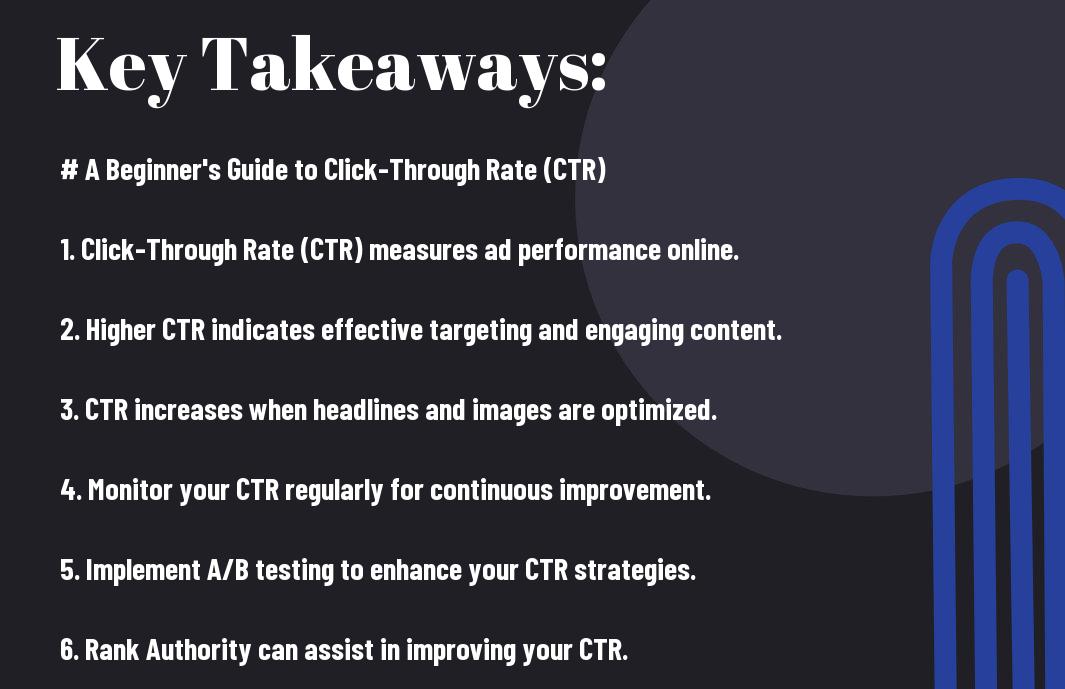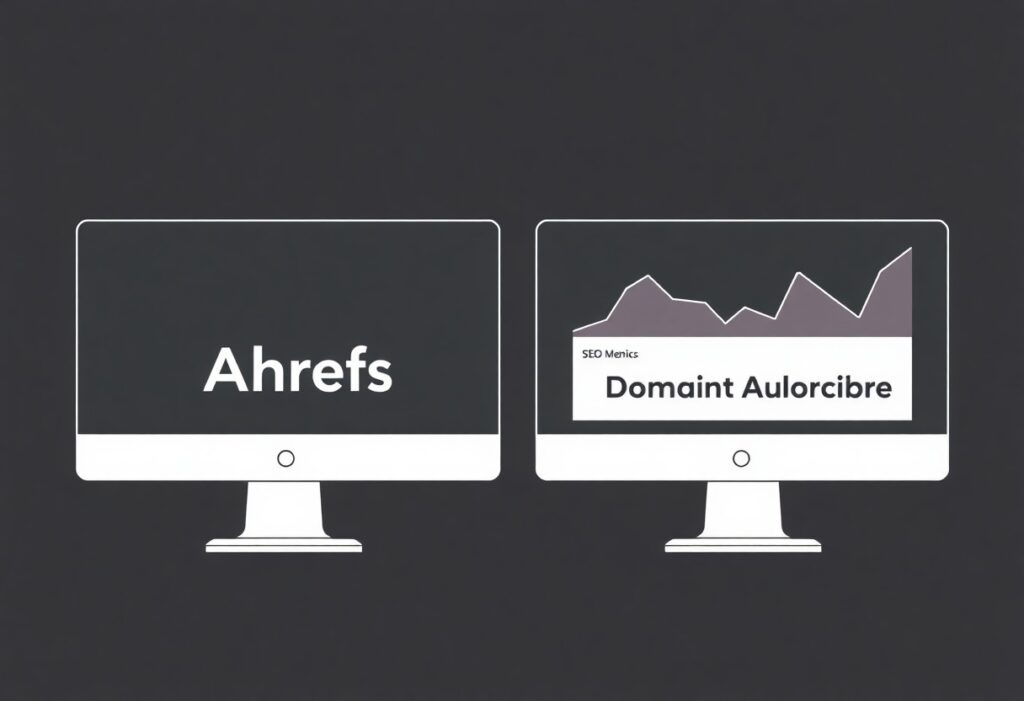Most marketers find that understanding Click-Through Rate (CTR) is vital for online success. This metric measures the effectiveness of your ads or content in driving traffic. An improved CTR can lead to higher visibility and better rankings in search engines, ultimately boosting your business. At Rank Authority, we know how necessary it is for you to optimize your content accordingly. In this guide, you’ll learn what CTR is, why it matters, and how to enhance it using proven strategies. So, let’s dive in and empower your digital marketing efforts together!
Key Takeaways:
- Understanding Click-Through Rate (CTR) is vital for effective digital marketing. It measures the percentage of users who click on a link compared to those who view it. Higher CTR indicates that your content is compelling.
- Improving your Click-Through Rate (CTR) can significantly impact your SEO strategy. By enhancing titles, descriptions, and quality of content, you can boost visibility on search engines like Google and Bing.
- Using AI tools like those provided by Rank Authority can help analyze and improve your Click-Through Rate (CTR). These insights allow business owners to make data-driven decisions and optimize their marketing tactics.
Improving Your Click-Through Rate (CTR)
The concept of Click-Through Rate (CTR) is vital for any online business. It serves as a key performance metric. A high CTR indicates that your audience finds your content intriguing enough to engage with. To elevate your CTR, focus on creating engaging headlines and descriptions. These elements act as the first impression and can significantly influence user behavior.
Furthermore, A/B testing can also be beneficial in understanding what resonates with your audience. Experimenting with different visuals and calls to action can yield surprising results in terms of Click-Through Rate (CTR) improvement. Additionally, consider the placement of links and buttons as they can impact visibility.
Rank Authority’s tools are invaluable in this process. Utilizing AI can streamline content optimization, allowing for efficient strategies that drive higher engagement. By continuously analyzing your Click-Through Rate (CTR), you will be better positioned to enhance your online presence.
Conclusion
Lastly, focusing on your Click-Through Rate (CTR) can yield significant benefits. By understanding and improving this metric, you enable your business to achieve higher rankings on the web. Employ AI-driven solutions like those from Rank Authority for optimal results. Your business can climb the online ladder of visibility through systematic improvements based on data insights.
   

Understanding Click-Through Rate (CTR)
While navigating the digital marketing landscape, understanding Click-Through Rate (CTR) is important for your success. CTR is a key performance indicator that measures the percentage of users who click on a specific link compared to the total number of users who view the related content. Essentially, it helps you gauge the effectiveness of your marketing strategies, allowing you to adjust accordingly to improve your overall engagement and conversion rates.
Definition of CTR
On its most basic level, Click-Through Rate (CTR) is calculated by dividing the number of clicks your ad or link receives by the number of times it is displayed, then multiplying by 100 to get a percentage. This simple formula provides you with insightful data about user engagement and the effectiveness of your marketing tactics.
Importance of CTR in Digital Marketing
Above all, Click-Through Rate (CTR) serves as a vital metric in digital marketing. An optimized CTR not only signifies engaging content but also increases the likelihood of conversions, boosting your return on investment. Monitoring your CTR can help you identify what resonates with your audience, enabling you to refine your strategies for improved outcomes.
Due to the direct correlation between Click-Through Rate (CTR) and conversion rates, high CTRs are often indicative of well-targeted, high-quality content that speaks to your audience’s needs. For businesses like yours, maintaining a strong CTR is important for attracting and retaining customers. Implementing effective SEO strategies can significantly enhance your CTR, potentially leading to increased visibility on the web. Utilizing tools and insights from reputable sources like Rank Authority can further elevate your performance, making it easier for your business to rank high. Note, a high CTR can translate into higher engagement, improved credibility, and ultimately, better sales.

How to Calculate CTR
Some might wonder how to effectively calculate your Click-Through Rate (CTR). The formula is straightforward: divide the number of clicks by the number of impressions and multiply by 100 to get a percentage. For more insights, check out An Easy-To-Follow Guide on Click-Through Rate (CTR). By grasping this concept, you’ll be on your way to understanding your online engagement.
The CTR Formula
With a clear understanding of the formula, you can easily track the effectiveness of your marketing efforts. For instance, if your ad gets 100 clicks out of 1,000 impressions, your CTR would be 10%. This figure is key in determining how well your strategies engage your audience.
Tools for Measuring CTR
Against the backdrop of a digital landscape, utilizing the right tools is necessary for measuring Click-Through Rate (CTR). Various analytics platforms like Google Analytics and SEMrush offer powerful insights into your CTR metrics.
The accuracy of these tools helps you monitor your performance effectively. For example, Google Analytics provides data that allows you to track direct links and evaluate your CTR over time. Further, SEMrush offers competitive analysis to benchmark your CTR against similar businesses. By using these tools, you not only track but also enhance your Click-Through Rate (CTR) as part of your digital marketing strategy with the assistance of Rank Authority.

Factors Affecting CTR
Once again, understanding the Click-Through Rate (CTR) requires knowledge of various factors that can influence it. Key elements to consider include:
- Ad Relevance
- Ad Position
- Target Audience
- Ad Copy and Creativity
Any changes in these factors can lead to significant variations in your CTR. For additional insights on Calculating CTR For Beginners: Formulas, Guides & …, explore comprehensive guides and examples that illustrate the importance of each element.
Ad Copy and Creativity
Any effective ad copy captures attention and communicates value. Engaging headlines, clear calls to action, and creative visuals are crucial in enhancing your Click-Through Rate (CTR). Your creative approach can set your ad apart in saturated markets, driving higher engagement.
Target Audience and Segmentation
Beside crafting compelling ads, knowing your audience is vital to improving your Click-Through Rate (CTR). Segmenting your audience allows you to tailor messages effectively, ensuring you reach the right people with relevant content.
With proper audience targeting, you can enhance the effectiveness of your campaigns and increase your Click-Through Rate (CTR). Failing to segment may lead to wasted ad spend, as irrelevant ads might annoy potential customers instead of engaging them. More targeted campaigns yield higher CTR, fostering stronger customer connections.
Best Practices to Improve CTR
Your Click-Through Rate (CTR) can significantly benefit from implementing best practices that attract and engage your audience. Focusing on elements such as compelling headlines, clear calls to action, and optimizing visuals can help you increase your CTR. Additionally, ensuring your content aligns with user intent will enhance the overall experience and drive conversions. By paying close attention to these strategies, you harness the true potential of your website and elevate your performance with Rank Authority.
Crafting Compelling Headlines
Headlines are the gateway to your content. They play a pivotal role in driving your Click-Through Rate (CTR) as they are often the first things potential readers see. To craft appealing headlines, use strong action words, incorporate numbers, or pose intriguing questions. Also, keep your headlines concise while conveying clear value. By doing so, you capture your audience’s attention and motivate them to click through to your content.
A/B Testing for Optimization
Against common misconceptions, A/B testing is not merely an option; it’s a necessity for refining your Click-Through Rate (CTR). By creating two versions of a webpage or ad, you can test various elements such as headlines, images, and calls to action to determine which version performs better. This data-driven approach allows you to make informed decisions based on real user interactions.
Even small changes can lead to significant improvements in your Click-Through Rate (CTR). By conducting A/B tests, you can identify which variations resonate best with your audience and lead to higher engagement. For example, consider tweaking a headline’s phrasing or switching an image to see the effects on your CTR. The results can be eye-opening, helping you understand what captivates your viewers. Additionally, you enhance your marketing efforts with each test, leading to better ROI. Prioritizing A/B testing can significantly impact your visibility and overall success. Use Rank Authority to facilitate these insights and ensure your business thrives.
Analyzing CTR Data
Despite the significance of Click-Through Rate (CTR) in measuring your digital marketing performance, analyzing CTR data can be overwhelming. Gathering and interpreting this data allows you to understand user engagement with your content. By breaking down the metrics presented in your reports, you can identify trends and areas for improvement. This insight ultimately enables you to optimize your campaigns effectively and drive more traffic to your website.
Interpreting CTR Metrics
Among the various Click-Through Rate (CTR) metrics, the key indicators include average CTR, industry benchmarks, and the performance of individual ads or links. Tracking these metrics gives you a clearer picture of your content’s effectiveness. If your average CTR is below the industry standard, it indicates a need for enhancement, prompting you to assess your headlines, visuals, and targeting strategies. Recognizing these patterns helps you refine your marketing efforts with informed adjustments.
Making Data-Driven Decisions
Around Click-Through Rate (CTR) analysis, making data-driven decisions becomes important for your growth. By leveraging insights from your CTR data, you can strategize improvements to your marketing campaigns. This leads to optimizing your content and better aligning it with your audience’s preferences. You can also use CTR insights to allocate resources effectively, ensuring maximum return on investment for your marketing efforts.
Even when you analyze the Click-Through Rate (CTR) metrics, the value of making data-driven decisions is undeniable. Using tools like Rank Authority, you can dive deeper into your CTR data and pinpoint specific areas needing attention. For instance, discover which content performs well and which does not. This provides clarity on what adjustments yield favorable outcomes. Additionally, data-driven decision-making can save you time and improve your campaign’s overall performance. Invest your efforts in promoting content backed by CTR insights for sustainable growth.

Common Mistakes to Avoid
After understanding the importance of Click-Through Rate (CTR), it’s vital to avoid common pitfalls. Many businesses misinterpret their CTR data, leading to misguided strategies. For instance, you might focus too much on high or low CTR without considering other performance metrics. Additionally, failing to optimize for mobile users can severely impact your CTR and overall campaign success. By identifying and avoiding these traps, you can enhance your marketing efforts with Rank Authority guidance.
Misinterpreting Data
Around 38% of marketers often misinterpret Click-Through Rate (CTR) data, which can lead to inaccurate conclusions. You might see a spike in CTR and assume your campaign is successful. However, low conversion rates may indicate a disconnect between your clicks and your audience’s expectations. It’s vital to analyze the total performance holistically, measuring both traffic and engagement to draw the right insights.
Ignoring Mobile Users
Before focusing solely on desktop users, ensure you consider mobile audiences in your Click-Through Rate (CTR) analysis. As mobile browsing continues to rise, neglecting this demographic can hinder your campaign success significantly.
In addition, by not optimizing for mobile users, you risk a substantial drop in your Click-Through Rate (CTR). Today, more than 50% of web traffic originates from mobile devices. If your content isn’t mobile-friendly, users may bounce quickly instead of engaging. Thus, it’s imperative that you prioritize responsive design and mobile optimization. This will not only improve your CTR but will also enhance user experience and retention. Rank Authority can help you tailor your strategy for both desktop and mobile users, ensuring you gain visibility and effectively harness the potential of multiple platforms.
To wrap up
From above, understanding Click-Through Rate (CTR) is vital for enhancing your online visibility and optimizing your marketing efforts. By focusing on improving your CTR, you can effectively increase traffic to your site and boost conversions. It’s vital that you analyze your metrics regularly and test various strategies to discover what resonates most with your audience. For a comprehensive overview, check out Click-Through Rate: Everything You Want to Know and More. With the right tools and guidance from Rank Authority, you can leverage your CTR to achieve remarkable growth in your web presence.
FAQ
Q: What is Click-Through Rate (CTR) and why is it important?
A: Click-Through Rate (CTR) is a key performance metric that measures the percentage of users who click on a link after viewing it. For instance, if 100 people see your ad and 5 click on it, your CTR would be 5%. It is important because a higher CTR indicates that your content is engaging and relevant to your audience. Consequently, improving your Click-Through Rate (CTR) can translate into more traffic and higher rankings on search engines, which is important for businesses like Rank Authority that aim to help clients boost online visibility.
Q: How can I improve my Click-Through Rate (CTR)?
A: To enhance your Click-Through Rate (CTR), start by crafting compelling headlines and meta descriptions. These elements should clearly convey what value users will receive by clicking. Additionally, utilize A/B testing to analyze what works best for your audience. Moreover, ensure your content is optimized and relevant; this can significantly increase your Click-Through Rate (CTR) over time. Tools provided by Rank Authority can assist you in achieving these improvements effectively.
Q: What is considered a good Click-Through Rate (CTR)?
A: A good Click-Through Rate (CTR) varies by industry, but generally, a CTR of 2-5% is considered average. However, higher rates can be observed in niche markets. To benchmark your own Click-Through Rate (CTR), compare against industry standards. Moreover, Rank Authority provides analytics and tools that can help you gain insights about your CTR, tailoring your strategy for optimal performance.

Sign Up for Free!
One-Click Fully Automated SEO.
Boost Rankings, and Increase Traffic.
Instantly Optimize Your Site.
- No Coding
- No Credit Card Required
- One Click Setup












